Duncan Smith, He/him she/her, Video Game Designer in the making.
Don't wanna be here? Send us removal request.
Text
okay but I did not know that there is a story about f. scott fitzgerald nervously showing ernest hemingway his penis because zelda said he couldn’t satisfy a woman with it and ernest hemingway was like “lol no dude you’re fine”
what are the modernists even
268K notes
·
View notes
Text
Handy Magic: Final Version
This game is two player magic dueling game using glove peripherals. Players put in combinations of different elements to form spells that they use to defeat their opponent.
Designed and built by Joyce Scallettar, Theoren Mathias, Duncan Smith, and Matthew Sandfrey.
In this game, each player has two gloves. They need to touch fingers to panels on the front and back of the gloves to create and use spells.
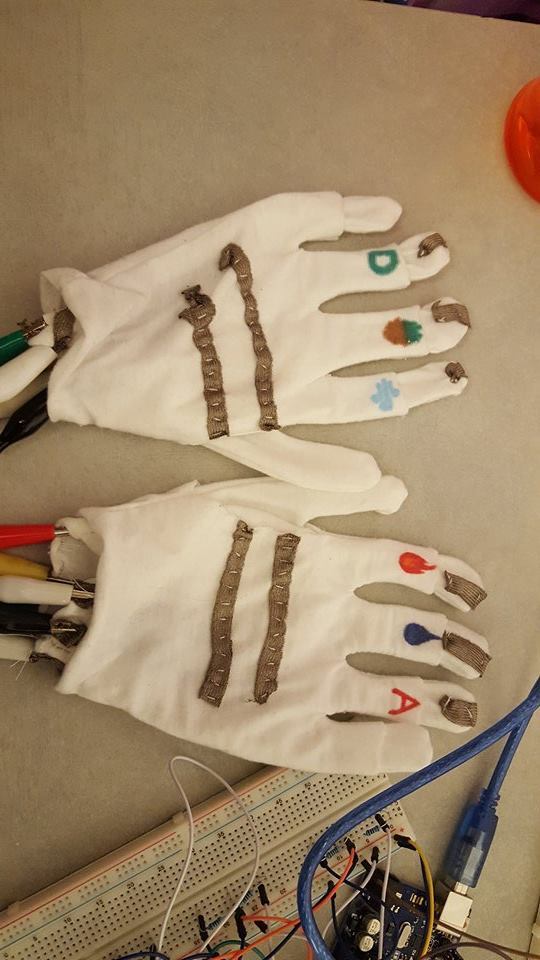
Each spell requires 3 ingredients, in no particular order: The two element combination that makes up the spell, plus whether it is being used for attack or defense. Each finger has a different property, which is inscribed on the finger (added after pictures were taken). There are six inputs which consist of four elements, fire, water, air and earth, as well as protection and attack.
These spells manifest in three ways. First, every time a valid spell configuration is entered, a hat lights up with the corresponding spell, thus allowing the other player to see what spells have been launched at them without looking at the game screen.
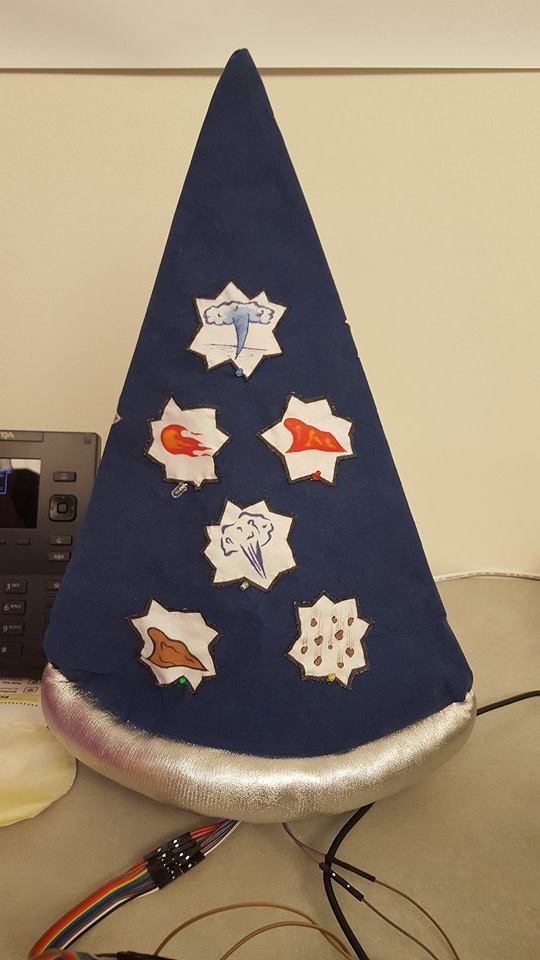
The second and third ways they manifest are based on the game mode. There is a 1p practice mode where the player must match spells as they show up on screen to practice and get points. There is also a 2p duel mode, where spells deplete the opposing player’s hp and kill them over time, or defend against spells of the corresponding type.
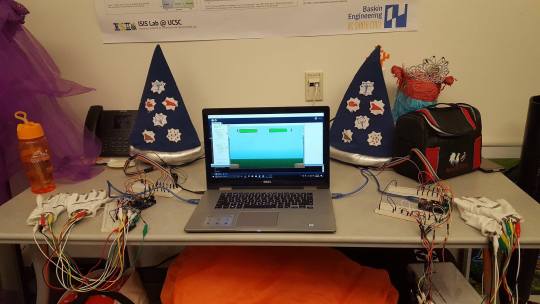
For each player we used a pair of double-layered gloves with conductive fabric sewn into them which had two different IO types: Resistors, and voltage. Each of the fingers was connected to an analog output from the arduino, thus supplying voltage to the system. Whenever they touched a resistor panel, it took voltage in and used a simple ohm meter to calculate which finger was being pressed on it. We used this system because it was much less complex and expensive than flex sensors, and allowed us to calculate finger inputs with near perfect precision.
These signals were then read from the two arduino boards into two serial ports, which were then piped into Processing. Processing then handled all the game logic.
This design was inspired by the intricate hand symbols used in different forms of sorcery throughout media. Everyone from wizards to ninjas uses some sort of hand symbol, so we thought that we could try and create part of that experience for our players.
This is the dev blog post of Duncan Smith. I was the sole Processing programmer on this project. I built the entire game client, with the rest of the team working on the hardware and arduino code.
Game footage and trailers:
youtube
youtube
youtube
0 notes
Text
Handy Magic Testing Update
To get the basic gist of the project, check out my midterm devblog over at https://duncansmithdev.tumblr.com/post/160759323123/handy-magic-midterm-prototype
In this update, we have totally revamped the gloves. Taking out the conductive tape, we have replaced it with sewn on conductive fabric in a double layer glove. This is a major change, and makes the gloves extremely consistent and ready to use for testing.
We don’t have any interface or design changes in this iteration, as all of the programming work went into the 2 player interface which is forthcoming. Currently, our game supports a single player mode just as in the last version. It will soon be able to support two players in head-to-head combat.
My changes are not visible on this version, as I have been building the two player setup.
0 notes
Text
Handy Magic: Midterm Prototype
This game is a singleplayer prototype of a two-player dueling game using glove peripherals. The players make hand signs and combinations with their fingers to cast spells, which in this version they are prompted to make. The eventual version of this will have players dueling each other with spells.
Designed and built by Joyce Scallettar, Theoren Mathias, Duncan Smith, and Matthew Sandfrey.
In this prototype, the player has two gloves. Three fingers on each hand are used for specific spell ingredients, which must be touched to the panels on the opposite hand to come into effect.
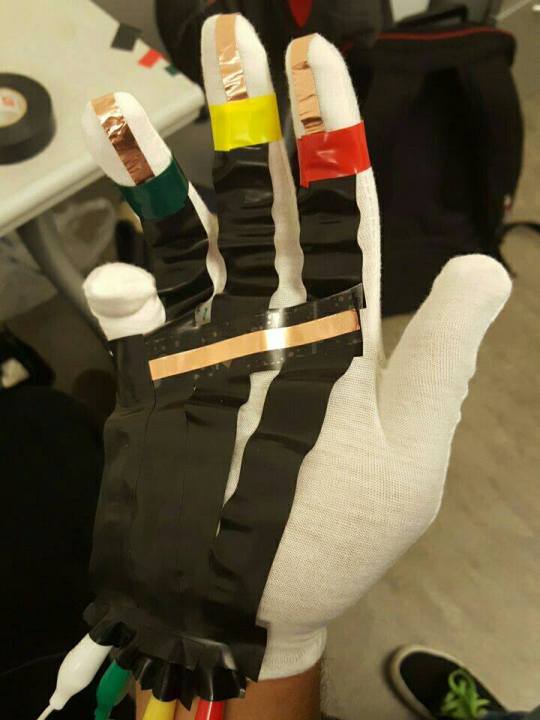
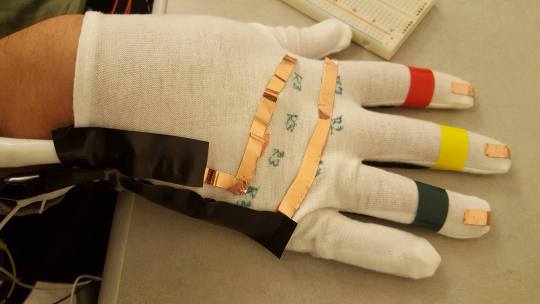
Each spell requires 3 ingredients, in no particular order: The two element combination that makes up the spell, plus whether it is being used for attack or defense. Each finger has a different property, which is inscribed on the finger (added after pictures were taken). There are six inputs which consist of four elements, fire, water, air and earth, as well as protection and attack.
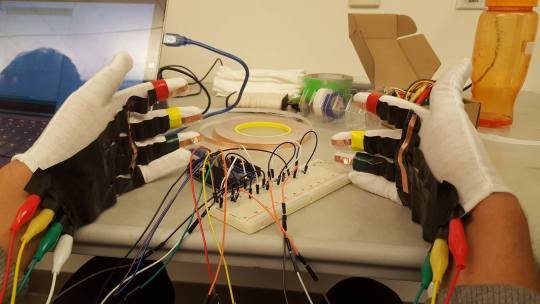
The screen in the prototype prompts the player as to what spell they need to make, and then has a countdown within which time frame the user must input the correct command. If they do not, a new command is set and they get no points. The user gets points based on how quickly they can perform the command shown on screen.
We used a pair of gloves rigged up with conductive tape which had two different IO types: Resistors, and voltage. Each of the fingers was connected to an analog output from the arduino, thus supplying voltage to the system. Whenever they touched a resistor panel, it took voltage in and used a simple ohm meter to calculate which finger was being pressed on it. We used this system because it was much less complex and expensive than flex sensors, and allowed us to create a system with moderate accuracy relatively quickly. It does, however, have precision flaws that need to be fixed in iteration for the final design.
This design was inspired by the intricate hand symbols used in different forms of sorcery throughout media. Everyone from wizards to ninjas uses some sort of hand symbol, so we thought that we could try and create part of that experience for our players.
This is the dev blog post of Duncan Smith. I was the sole Processing programmer on this project. I built the entire game client, with the rest of the team working on the hardware and arduino code.
There is a demonstration of a minute or so of game footage posted below.
youtube
0 notes
Text
Brainstorming Assignment
Brainstorming idea 1
Submarine Sonar:
This game would involve a sonic distance sensor, a photo-resistor, a pair of headphones, and a blindfold. This game works for as many players as you have setups for, with a referee. Two or more players are placed in an arena blindfolded, with a photo-resistor on a headband attached to their head. While they are blindfolded their sonic distance sensor pings and finds other people in the arena, then makes a sound whose volume and 3d spatial properties (surround sound) is modulated based on how close they are to objects around them. They have to try and find the other players while using this sound system. If they find another player, they have to be within 3 feet of them, point directly at them, and say “torpedo.” The distance doesn’t have to be fully precise, as it is decided by a referee. The photo-resistor on their head is for the second mechanic, where a player may take off their blindfold. If they do, however, they are not allowed to move or fire torpedoes, and they have to loudly announce that they are “surfacing” when they do, and they have to stay surfaced for at least 15 seconds. They cannot surface within a minute of previously surfacing.
This game is inspired by a game I played at GDC called Captain Sonar. Captain Sonar was an interesting board game, but there was a lot of extremely difficult team play that ended up not always being very fun. This game, however, would be a non-team game with a lot elements inspired by it.
This game was not designed for two players. It can be played with two players, but you’ll really want three. That way they sonar is less accurate; the more players there are, the more confusing your sonar signals are, and the less more likely it is that you will need to surface, a mechanic that has drawbacks to its use.
The game is designed to try and encourage players to both seek out their opponents but also be methodical and slow, due to the aspect of being completely blind. Running is not encouraged due to tripping and also the inaccuracy of movement.
There are two elements of this game that I would want to iterate on in order to make it a little better. First, it has actually a disincentive for spectators, as the distance sensor gets confused if other people are around. Second, I want to get rid of the referee, but I’m unsure how.
Brainstorming Idea 2:
Words of Power:
Words of Power is a fighting game that uses voice commands to move and attack. Both players are using a microphone that’s querying the google voice command api, which lets them input voice commands to move and attack with their character. However, this game uses the volume at which they say their commands to provide modifiers to the attack. Thus, the game involves three different attack modifiers relating to dB volume ranges, such as high, middle, and low.
Thus this creates a different take on the Street Fighter style of game, wherein planning and prediction are just as important as they were before. Google Voice Commands is not a quick system; the player will have to predict their opponent’s moves to be able to block them in time.
This idea is rough; there isn’t much to it beyond the fighting game element. It does add an interesting aspect to the Street Fighter style of games, that works to emphasize the slowness and prediction and not the combos.
0 notes